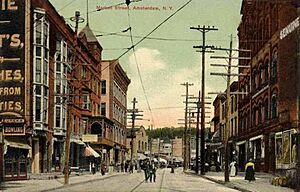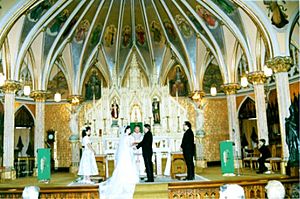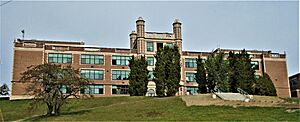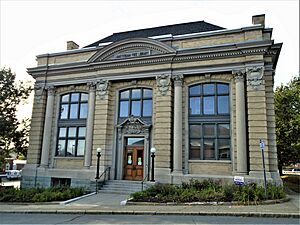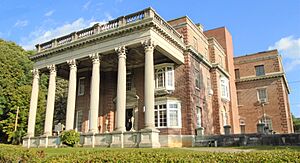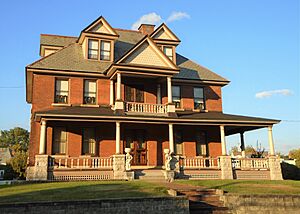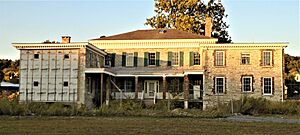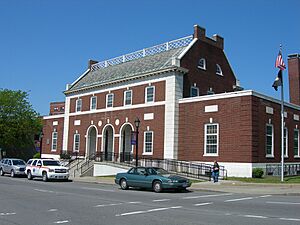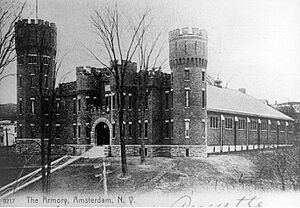Amsterdam, New York facts for kids
Quick facts for kids
Amsterdam, New York
|
|
|---|---|
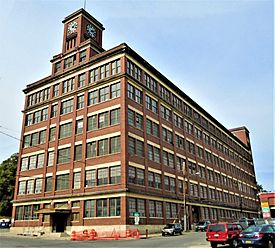
The Sanford Clock Tower, built in 1922
|
|
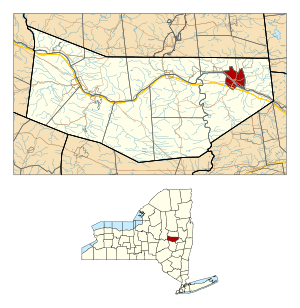
Location within Montgomery County and the state of New York
|
|
| Country | United States |
| State | New York |
| County | Montgomery |
| Incorporated (village) | 1830 |
| Incorporated (city) | 1885 |
| Government | |
| • Type | Mayor-council |
| Area | |
| • Total | 6.26 sq mi (16.21 km2) |
| • Land | 5.87 sq mi (15.21 km2) |
| • Water | 0.39 sq mi (1.00 km2) |
| Elevation | 361 ft (110 m) |
| Population
(2020)
|
|
| • Total | 18,219 |
| • Density | 3,102.16/sq mi (1,197.82/km2) |
| Time zone | UTC−05 (Eastern (EST)) |
| • Summer (DST) | UTC−04 (EDT) |
| ZIP code |
12010
|
| Area code(s) | 518 and 838 |
| FIPS code | 36-02066 |
| GNIS feature ID | 0942450 |
| Website | City of Amsterdam website |
Amsterdam is a city in Montgomery County, New York, United States. In 2020, about 18,219 people lived there. The city is named after Amsterdam in the Netherlands.
The City of Amsterdam is surrounded by the town of Amsterdam on its northern, eastern, and western sides. The city grew on both sides of the Mohawk River. Most of it is on the north side, but the Port Jackson area on the south side is also part of the city.
Contents
History of Amsterdam, New York
Who lived here first?
Before Europeans settled here, the Mohawk tribe lived in the Amsterdam area for hundreds of years. They were part of the Iroquois Confederacy. They were very powerful in the Mohawk Valley.
When did Dutch settlers arrive?
Dutch settlers started coming to this area in the 1660s. They founded Schenectady in 1664. They reached the future Amsterdam around 1710. They called the place Veeders Mills or Veedersburgh. This was named after Albert Veeder, who owned an early mill. Later, in the 1700s, immigrants from Scotland, Ireland, and Germany also arrived in the Mohawk Valley.
How did Amsterdam grow after the American Revolution?
The American Revolutionary War did not have a big impact on Amsterdam. No major battles happened there. After the war, the city grew slowly. It mainly provided services for nearby farms. In 1803, the city changed its name to Amsterdam. This might have been to help it become the main town center.
After the war, many new settlers came from New England. The city became a village on April 20, 1830.
What helped Amsterdam become a manufacturing center?
This was a time of fast growth for the village. New transportation routes helped a lot. The Mohawk Turnpike, the Erie Canal, and a new railroad all made trade better. Local creeks, flowing from the Adirondacks, powered many mills. These mills made goods that were shipped out by land, canal, and rail.
Amsterdam became known for making things like linseed oil, brooms, and iron goods. But it was most famous for its carpets. It became the main center for carpet and rug making in the U.S.
When did Amsterdam become a city?
From the late 1800s to the early 1900s, many immigrants came to Amsterdam. People from Ireland, Italy, Poland, and Lithuania found jobs in the factories.
In 1865, Amsterdam had 5,135 people. The village grew bigger in 1854, 1865, and 1875. In 1885, Amsterdam officially became a city. It grew by adding Rockton to the north and Port Jackson (south of the Mohawk River). By 1920, the city's population was 33,524.
What happened to Amsterdam's industries?
During the Great Depression, factories slowed down but did not close. The city survived both World Wars without major problems. But after World War II, many factories started moving to the southern United States. They found cheaper labor and lower taxes there. Amsterdam's mills also moved their jobs south.
Also, younger generations often left Amsterdam for college and did not return. There were not many jobs for them in the city. Amsterdam tried to bring back its industries, but it was hard.
Later, city projects meant to improve travel and rebuild the city actually changed its unique feel. As the city's website says, these projects made it "harder to get there."
In the early 2000s, Amsterdam was still trying to find its new purpose. In August 2011, Hurricane Irene caused serious flood damage. Properties near the river were threatened by erosion and water.
Geography of Amsterdam
Amsterdam covers about 6.3 square miles (16.3 km2). About 5.9 square miles (15.4 km2) is land, and 0.3 square miles (0.9 km2) is water. The city is built on both sides of the Mohawk River and the Erie Canal. Two creeks, North Chuctanunda Creek and South Chuctanunda Creek, flow into the Mohawk River in Amsterdam.
How do people travel in Amsterdam?
New York State Route 30 goes north-south through the city. It's called Market Street in some parts. This highway crosses the Mohawk River and connects to the New York State Thruway. Route 30 also meets other main roads, New York State Route 5 and New York State Route 67, in the city. New York State Route 5S runs along the south side of the Mohawk River.
Amsterdam is part of New York's 20th congressional district.
Economy and Jobs in Amsterdam
What industries were important in Amsterdam's past?
In the 1800s, Amsterdam was famous for making carpets, textiles, and pearl buttons. In the 1900s, big carpet companies like Bigelow-Sanford and Mohawk Mills Carpet were in Amsterdam. But these companies later moved away.
Amsterdam was also home to Coleco. This company made popular toys and games like the ColecoVision and Cabbage Patch Kids. Coleco started in 1932 as the Connecticut Leather Company. It went out of business in 1988 after trying to get into the electronics market.
What is the economy like today?
The Amsterdam Riverfront Center is a shopping mall. It used to have many clothing stores. Now, it has offices for doctors, public services, community groups, a radio station, and a betting site.
| Historical population | |||
|---|---|---|---|
| Census | Pop. | %± | |
| 1840 | 1,700 | — | |
| 1850 | 2,000 | 17.6% | |
| 1860 | 2,044 | 2.2% | |
| 1870 | 5,426 | 165.5% | |
| 1880 | 9,466 | 74.5% | |
| 1890 | 17,336 | 83.1% | |
| 1900 | 20,929 | 20.7% | |
| 1910 | 31,267 | 49.4% | |
| 1920 | 33,524 | 7.2% | |
| 1930 | 34,817 | 3.9% | |
| 1940 | 33,329 | −4.3% | |
| 1950 | 32,240 | −3.3% | |
| 1960 | 28,772 | −10.8% | |
| 1970 | 25,524 | −11.3% | |
| 1980 | 21,872 | −14.3% | |
| 1990 | 20,714 | −5.3% | |
| 2000 | 18,355 | −11.4% | |
| 2010 | 18,620 | 1.4% | |
| 2020 | 18,219 | −2.2% | |
| 2021 (est.) | 18,187 | −2.3% | |
| sources: | |||
Amsterdam has a local newspaper called The Recorder. There's also an online newspaper, The Mohawk Valley Compass. Two AM radio stations, WVTL and WCSS, serve the area.
In the early 2000s, new distribution centers were built near Amsterdam. These include places like Target, Hill & Marks, Alpin Haus, and Dollar General. In 2019, Vida Blend also started building a new center. These businesses now employ thousands of people from Amsterdam and nearby areas.
People and Population (Demographics)
How many people live in Amsterdam?
In 2010, there were 18,620 people living in Amsterdam. There were 8,324 households and 4,721 families. About 25% of the people were under 18 years old. About 15.8% were 65 or older. The average household income from 2007 to 2011 was about $38,699.
In 2020, the population was 18,219 people, with 7,383 households. About 69.5% of the people were White, 6.4% African American, and 1.8% Asian. People of Hispanic or Latino origin made up 30.6% of the population. The average household income was $43,164. About 23.8% of the people lived below the poverty line.
Transportation in Amsterdam
How can you get around Amsterdam?
Amsterdam is located where State Routes 5, 30, and 67 meet. The New York State Thruway (Interstate 90) is less than a mile southwest of the city.
You can also travel by train with Amtrak. Three trains stop daily at the Amsterdam Station. This station is located off State Route 5 in the western part of the city.
- The Maple Leaf train travels between Toronto and New York City.
- Two Empire Service trains travel between Niagara Falls and New York City.
In 2022, CDTA started offering bus services in Amsterdam. They have two routes within the city, an express route to the Thruway, and a route between Amsterdam and Schenectady.
For electric cars, Amsterdam has two fast chargers. These are located in a city parking lot downtown, near the Amsterdam Free Library. Other chargers are also available in various city parks.
Sports in Amsterdam
- Amsterdam has a city golf course designed by Robert Trent Jones.
- The city is home to the Amsterdam Mohawks baseball team. They play in the Perfect Game Collegiate Baseball League at Shuttleworth Park.
- The Professional Wrestling Hall of Fame was in Amsterdam until November 2015, when it moved to Texas.
Places to Visit in Amsterdam
What are some interesting places to see?
- The Mohawk Valley Gateway Overlook is a pedestrian bridge. It crosses the Mohawk River and connects the downtown area to Riverlink Park. It was built between 2014 and 2016.
- Lock E11 helps boats travel on the Mohawk River and Erie Canal. It has a special structure with steel gates that can be opened or closed to control the river's water level.
- The Sanford Clock Tower was built in 1922. It was once the headquarters for a carpet company. Later, it was where Cabbage Patch Kids dolls and ColecoVision games were made. Today, it's called the Clock Tower Complex. The owners hope to attract new businesses to the building.
Even though some old parts of the city were changed for new roads, many historic buildings remain. These are listed on the National Register of Historic Places.
- The Amsterdam (46th Separate Company) Armory was built in 1895 for the New York Army National Guard. It's now a bed and breakfast called the Amsterdam Castle.
- Amsterdam City Hall was built in 1869 as the home of carpet owner Stephen Sanford. In 1932, it became the city hall.
- The Amsterdam Free Library is a Carnegie library. It was built in 1903 with money from Andrew Carnegie.
- The Gray-Jewett House was built in 1890.
- Green Hill Cemetery is a historic cemetery.
- The Greene Mansion was built in 1881.
- Guy Park Manor was built in 1774 in the Georgian style. It was the home of Guy Johnson, a British official. This house was damaged by Hurricane Irene.
- The Guy Park Avenue School was built in 1902 and closed as a school in 1968.
- The Samuel Sweet Canal Store was built in 1847. It served boats on the Erie Canal as a store and warehouse.
- The Saint Stanislaus Roman Catholic Church Complex includes a church (1897), a school (1906), a former convent (1934), and a rectory (1941).
- The Temple of Israel is a synagogue built in 1901.
- The United States Post Office was built in 1936.
- The Vrooman Avenue School was built in 1916 and closed as a school in 1975. It is now an apartment building.
The Chalmers Knitting Mills was added to the NRHP in 2010, but it was later taken down.
Places of Worship
- Calvary Assembly of God
- Kingdom Hall of Jehovah's Witnesses
- Congregation Sons of Israel (Jewish)
- Covenant Presbyterian Church
- Crossroads Community Church
- Five Buddha Temple
- First Baptist Church of Amsterdam
- First Reformed Church
- Goddess of Mercy Temple (Buddhist)
- Iglesia de Dios, Torre Fuerte
- Lord of the Harvest Church
- Our Lady of Mount Carmel (Catholic)
- Pilgrim Holiness Church
- Salvation Army
- Segunda Sinagoga
- Seventh-day Adventist Church
- St. Ann's (Episcopal)
- St. Luke's (Lutheran)
- St. Mary's (Roman Catholic)
- St. Nicholas (Ukrainian Catholic)
- St. Stanislaus (Roman Catholic)
- The Time for Truth
- Trinity Lutheran
- United Presbyterian Church
Education in Amsterdam
Public Schools
Elementary Schools
- William H. Barkley Elementary School
- William B. Tecler Elementary School (located in the Town of Amsterdam)
- Marie Curie Elementary School
- Raphael J. McNulty Elementary School
Secondary Schools
- Wilbur H. Lynch Literacy Academy
- Amsterdam High School (located in the Town of Amsterdam)
Private Schools
- St. Mary's Institute
Library
The Amsterdam Free Library is at 28 Church Street. It's a Carnegie library built in 1902-1903. Andrew Carnegie, a famous helper of libraries, gave $25,000 for it.
Arts and Music
Amsterdam has a lively arts scene. Amsterdam High School is home to the award-winning Amsterdam Marching Rams band. They are one of the best marching bands in the area. The high school also has a great theater program. Performances are held in the Bert DeRose Theatre.
The community also has music groups. The Mohawk Valley Choir has groups for elementary, middle, and high school students, as well as adults. The Mohawk Valley Chamber Ensembles are also part of this program.
Famous People from Amsterdam
Many notable people have lived in or are from Amsterdam:
- Gary Aldrich, an FBI agent.
- Bruce Anderson, a Medal of Honor winner from the Civil War.
- Benedict Arnold (1780–1849), a U.S. Congressman.
- Felix Joseph Aulisi, a New York Supreme Court Justice.
- Josh Beekman, a former National Football League player.
- Benjamin Paul Blood, an inventor, poet, and philosopher.
- Roger Bowman, a professional baseball player.
- Lucille Bremer, an actress.
- Tim Buckley, a musician.
- Dr. Tom Catena, a doctor and humanitarian.
- Todd Cetnar, played professional basketball in the United Kingdom.
- William B. Charles, a former U.S. Congressman.
- Jessica Collins, an actress.
- Charles Dayan, a U.S. Congressman and former Lieutenant Governor of New York.
- Kirk Douglas, a famous actor.
- W. Barlow Dunlap, a lawyer and politician.
- Andre Jackson Jr., a basketball player for the Milwaukee Bucks.
- Mary Anne Krupsak, a former New York State Lieutenant Governor.
- John Henry Manny, inventor of the Manny Reaper.
- H. Edmund Machold, a Speaker of the New York State Assembly.
- Chris Marcil, a television producer, writer, and actor.
- George Miles, a Michigan Supreme Court justice.
- Marilyn Hall Patel, a federal judge.
- Rocco Petrone, a director for the Apollo program.
- Todd Pettengill, a former professional wrestling announcer.
- David Pietrusza, an author and historian.
- Homer P. Snyder, a former U.S. Congressman.
- Lewis Strang, a racing driver.
- Vernon Tichenor, a Wisconsin State Assemblyman.
- Ray Tomlinson, who created the first person-to-person network email.
- Paul Tonko, a current U.S. Congressional Representative.
- Beth Van Duyne, a U.S. Congressional Representative.
- Samuel Wallin, a former U.S. Congressman.
- Willis Wendell, an industrialist and New York State Senator.
- Harrison Wilson, Jr., an American educator and college basketball coach.
- Ruth Zakarian, Miss Teen USA 1983.
|
See also
 In Spanish: Amsterdam (Nueva York) para niños
In Spanish: Amsterdam (Nueva York) para niños




